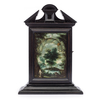Italian night clock
Global shipping available
- Origin
- Italy
- Period
- C. 1680
- Material
- Blackened fruitwood, Brass
- Signature
- Attributed to Ludovico Manelli a Bologna
- Literature
E. Morpurgo, Dizionario degli orologiai Italiani, Rome 1974, p. 106, 224, 227.
A. Simoni, Orologi Italiani dal '500 all' '800, 1973, p. 102, 112, 113, 114, 129.
H. M. Vehmeyer, Clocks - their origins and development 1320 - 1880, Gent 2004 vol. II, p. 948, 949, cat. no. 12.
Questions about this object?
Please use one of the contact options below:
Description
This Italian late Renaissance night clock of blackened fruitwood is attributed to Ludovico Manelli a Bologna. At the back of the clock, an oil lamp could be placed on the shelf; this illuminated the numeral ring and dial at the front, allowing one to read the time even in the dark. The hours are indicated in Roman numerals. The front of the clock is painted with a landscape with a waterfall, in which a man with a staff stands in the foreground looking at two people in the distance. The sides of the landscape are framed by large trees, and the brass dial is painted with clouds. The profiled case of the night clock has a bell gable with two sloping sides and is raised on a tapering foot. The back of the box can be opened and closed with a hook. The going train with verge escapement, is decorated with openwork floral motifs. The duration of the clock is 21 hours.
Night clocks of this type are an Italian 17th century invention that also became popular in the rest of Europe and mainly England. The paintings on the dial ranged from religious to allegorical, and made the clock a piece of furniture in its own right. Technical developments that allowed for more precise indication of time eventually caused the night clock to fall out of fashion.









